Chatbots vs Conversational AI: What’s the Difference?
Check out the key differences between chatbots vs conversational AI. Go through their capabilities, use cases and benefits to help businesses choose the right solution for customer engagement.
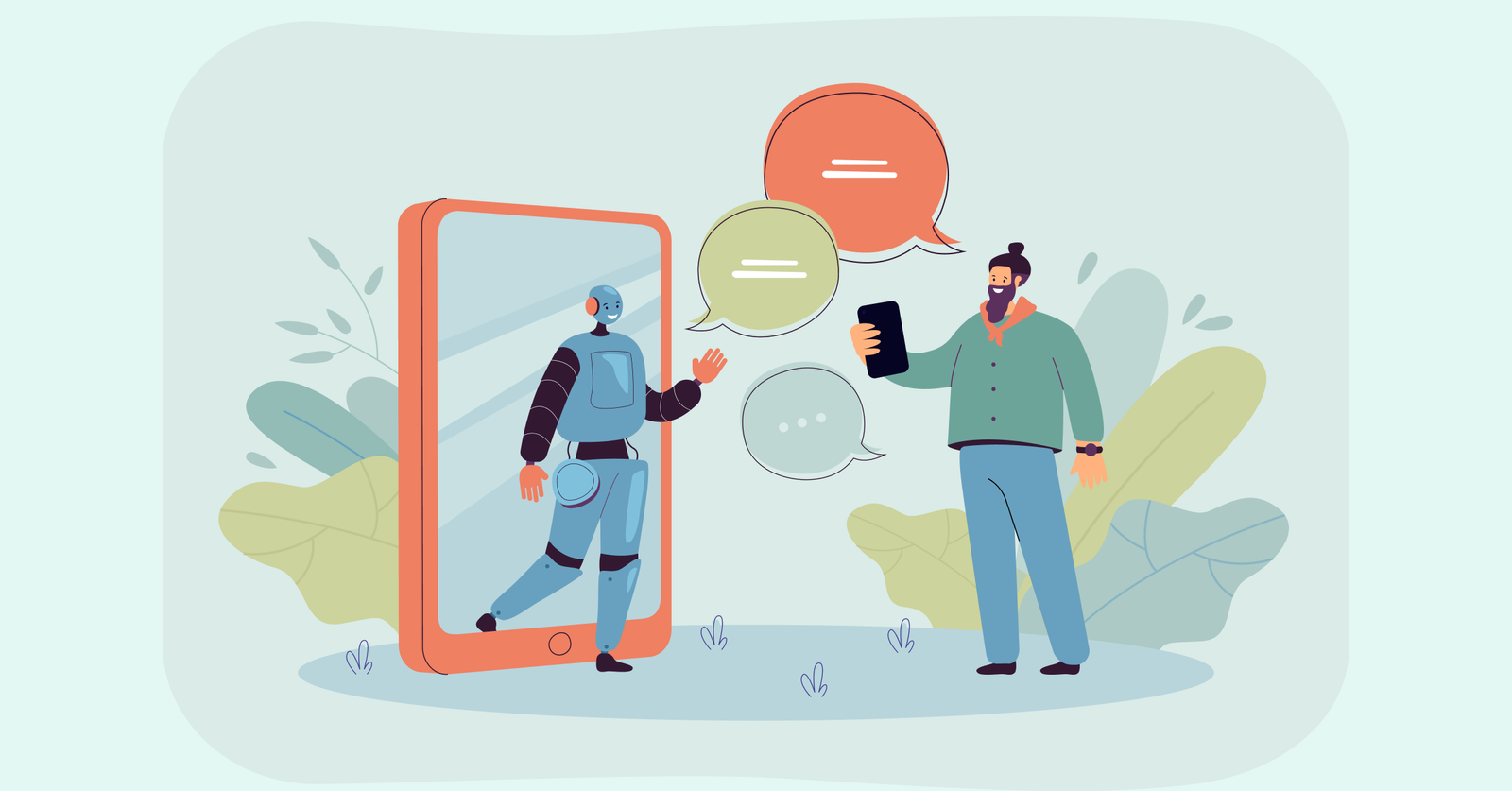
Check out the key differences between chatbots vs conversational AI. Go through their capabilities, use cases and benefits to help businesses choose the right solution for customer engagement.

A lot of businesses aren’t sure if a simple chatbot will do the job or if they actually need conversational AI. That uncertainty often ends with clunky tools, annoyed customers and missed chances to solve problems well.
Pick the wrong setup and you’re stuck with scripted replies that can’t go beyond basic FAQs, while competitors move ahead with systems that grasp context and respond naturally.
Knowing the real differences between chatbots vs conversational AI makes it easier to choose wisely, handle complex queries smoothly and build interactions that actually work for both customers and the business.
Chatbots refer to computer programs that simulate conversation and provide automated responses to users. They can be integrated into websites, apps or messaging platforms to offer instant support around the clock. Chatbots help reduce wait times and ease the workload for support teams by handling multiple conversations at once
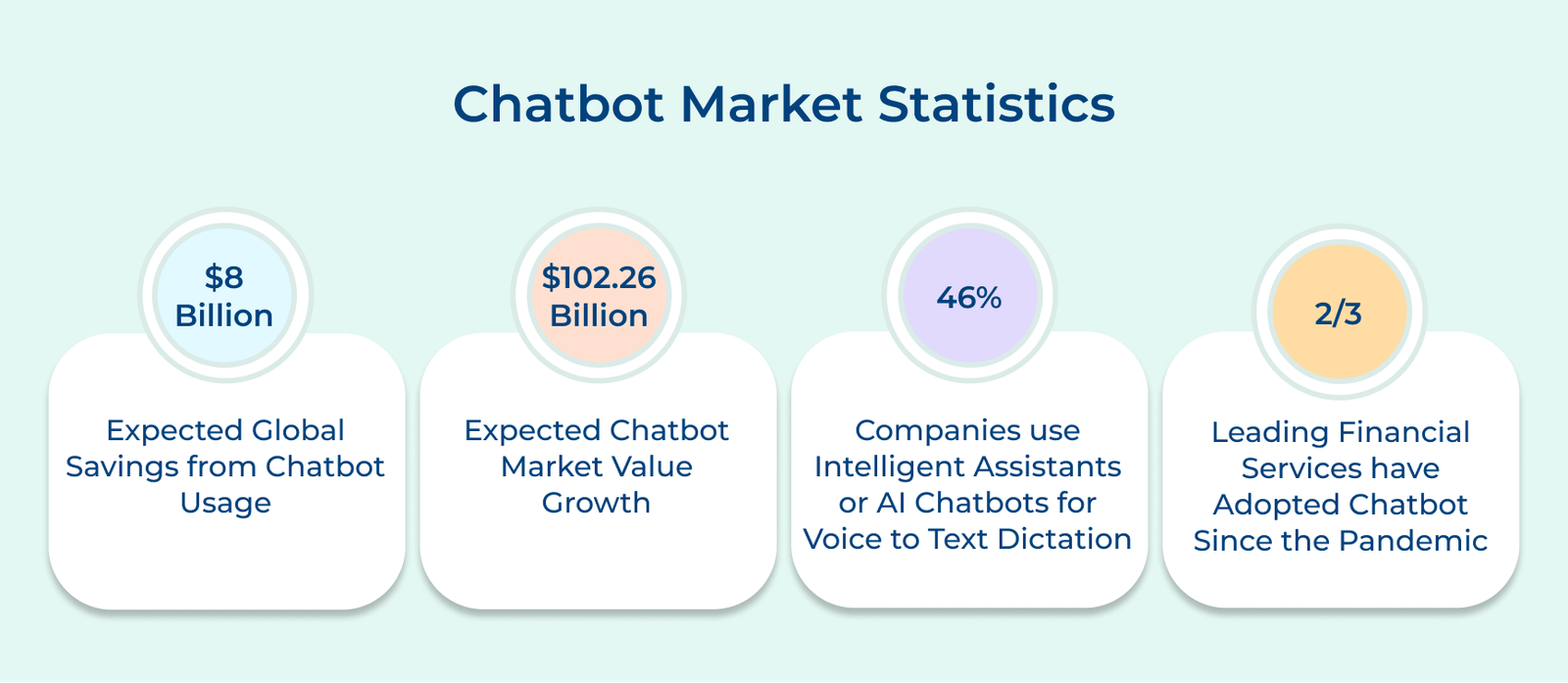
The digital assistants have revolutionized customer interactions by providing 24/7 availability and instant responses. Modern chatbots can handle multiple conversations simultaneously, reducing wait times and operational costs for businesses.
Key types:
Conversational AI refers to a technology that allows computers to hold human-like conversations. It uses natural language processing (NLP) and machine learning to understand what people say or type, then respond in a natural way. Essentially, it aims to bridge the gap between humans and machines, making interactions with technology more seamless.
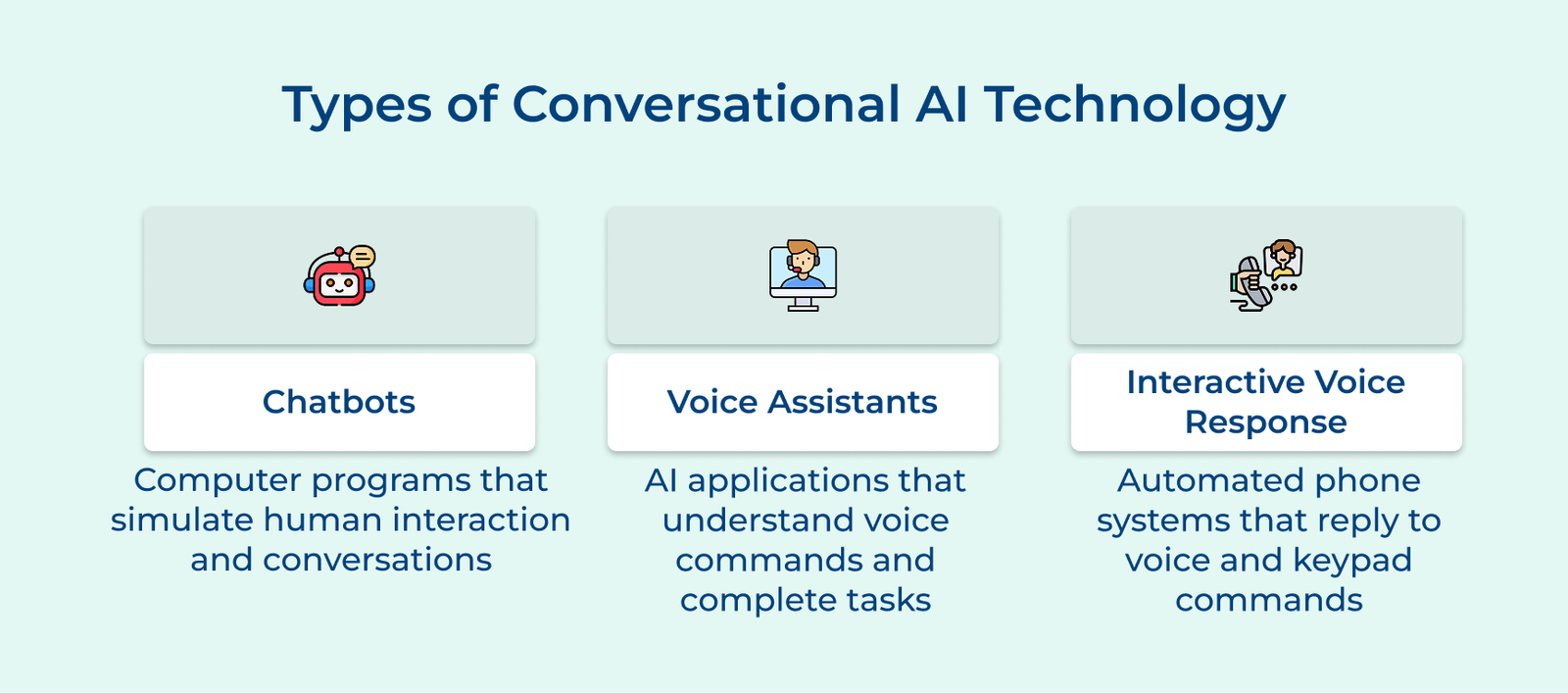
Unlike traditional interfaces that rely on fixed commands or menus, conversational AI lets users interact in plain, everyday language. Over time, it learns from the interactions, improving its grasp of context, user intent and subtle communication cues.
Key types:
The following are the key differences between chatbots vs conversational AI. Let’s check them out in more detail.
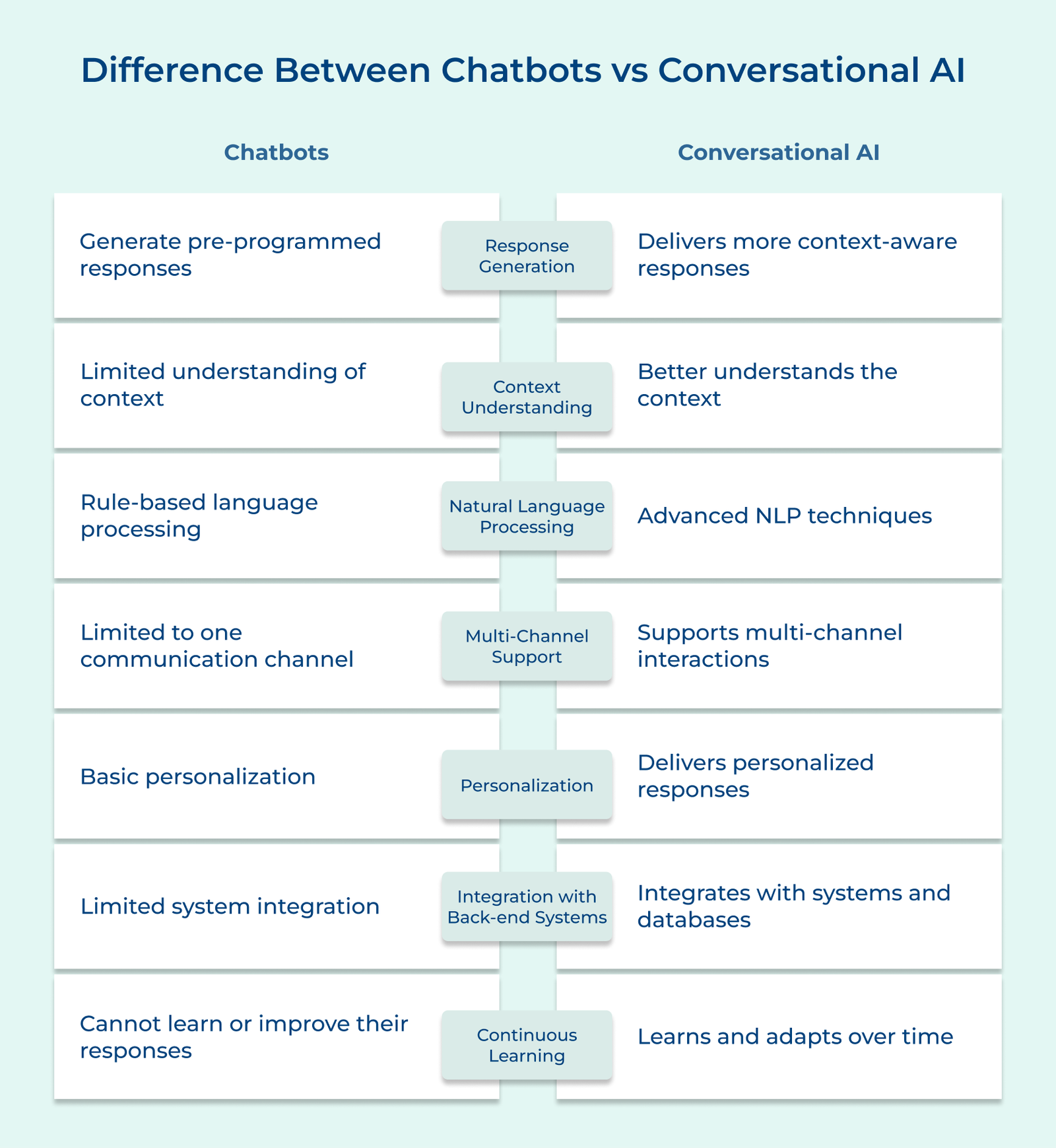
Chatbots usually rely on fixed rules to generate responses. It can limit the chatbot’s ability to adapt to more complex or nuanced queries, leading to potential limitations in its overall effectiveness.
Conversational AI goes further by using natural language processing and machine learning to interpret questions in real time. It can adapt its responses to context, making conversations more accurate and natural.
Pro tips:
Rule-based chatbots can only react to predefined keywords or phrases programmed into their system. They often miss the bigger picture and may provide irrelevant or incomplete responses.
Conversational AI uses machine learning and natural language processing (NLP) to interpret context. It allows it to understand intent, follow the flow of conversation and respond in a way that feels more natural.
Actionable tips
Rule-based chatbots rely on fixed scripts. They can answer basic questions but often fail when conversations move beyond what’s pre-programmed.
Conversational AI uses machine learning and NLP algorithms to pick up on context, tone and subtle variations in phrasing. It allows it to respond in ways that feel more accurate and human-like.
Key takeaways:
Basic chatbots usually stick to text-based replies and can only handle simple questions on a single platform. Their limitations show when conversations get complex or move across channels.
Conversational AI can adapt to different platforms whether chat, voice or messaging apps. It understands intent and context, making it more effective at keeping conversations consistent across multiple touchpoints.
Best practices:
Chatbots can answer common questions quickly but often feel generic. Since they rely on pre-set scripts, they struggle with unique requests or adapting to individual users.
Conversational AI learns from past interactions and user behavior. It helps it adjust responses and provide a more tailored experience that feels relevant.
Pro tips:
Chatbots are limited in integration, designed mainly for simple, rule-based interactions. They can provide basic information or handle straightforward tasks. However, they may struggle with more complex queries or tasks that require accessing multiple data sources.
Conversational AI integrates seamlessly with various back-end systems. Using natural language processing and machine learning, it understands user intent, accesses multiple data sources and delivers more personalized responses.
Actionable tips:
Chatbots are rule-based systems that can only respond to predefined commands and questions. They are limited in their ability to learn and grow, as they can only do what they are programmed to do.
Conversational AI understands natural language and context, enabling dynamic, engaging conversations. The systems continuously learn from interactions, refining responses and improving over time.
Key takeaways:
Chatbots have limited scalability due to their rule-based design. As interactions increase or queries become more complex, they may slow down or deliver inconsistent responses.
Conversational AI systems are designed with an advanced architecture that can handle massive-scale operations efficiently. They use cloud-based, distributed systems to handle thousands of conversations simultaneously while keeping performance and responses consistent.
Best practices:
Check out the examples of how chatbots and conversational AI are transforming industries, influencing the way we communicate.
Leading brands across industries have successfully implemented chatbots to enhance customer support and streamline service operations.
Amazon Chatbot
Amazon’s customer service chatbot handles everyday inquiries such as order tracking and return requests. It provides immediate responses for common issues and hands off more complex questions to human agents.
The chatbot has significantly reduced response times and operational costs while improving customer satisfaction. Amazon can now provide round-the-clock support without increasing staffing requirements or infrastructure expenses.
HDFC Bank’s EVA
HDFC Bank’s Electronic Virtual Assistant (EVA) assists customers with banking queries. It includes checking account balances and reviewing transaction history, all through conversational interfaces. It handles thousands of requests daily while adhering to security and regulatory standards.
EVA has transformed HDFC’s customer service by reducing branch visits and call center volume. The bank now offers instant banking assistance that enhances customer experience and operational efficiency.
Sephora Reservation Assistant
Sephora’s chatbot enables customers to book makeup consultations and beauty services through messaging platforms. It also provides store details and product suggestions to support the booking process.
The reservation assistant has increased appointment bookings and reduced no-show rates for Sephora. It allows the beauty retailer to optimize staff scheduling while providing personalized service recommendations.
Advanced brands are leveraging conversational AI to deliver intelligent and personalized customer experiences that adapt to user needs.
Lyft
Lyft’s conversational AI provides real-time ride support through natural language interactions within its mobile app. It can handle questions about driver locations, trip changes and other ride details while keeping track of the conversation context.
The AI system has enhanced the user experience by providing instant personalized assistance during rides. Lyft now offers proactive support that reduces customer frustration and improves overall service reliability.
Honda
Honda’s conversational AI assists customers with vehicle maintenance scheduling and technical support via voice or text. It understands automotive terms and can give guidance based on a vehicle’s history or usage.
The AI solution has improved customer engagement and service efficiency for Honda dealerships nationwide. It enables personalized automotive support that strengthens customer relationships and increases service department utilization.
Check out how chatbots are redefining customer service and the various applications that could benefit your business.
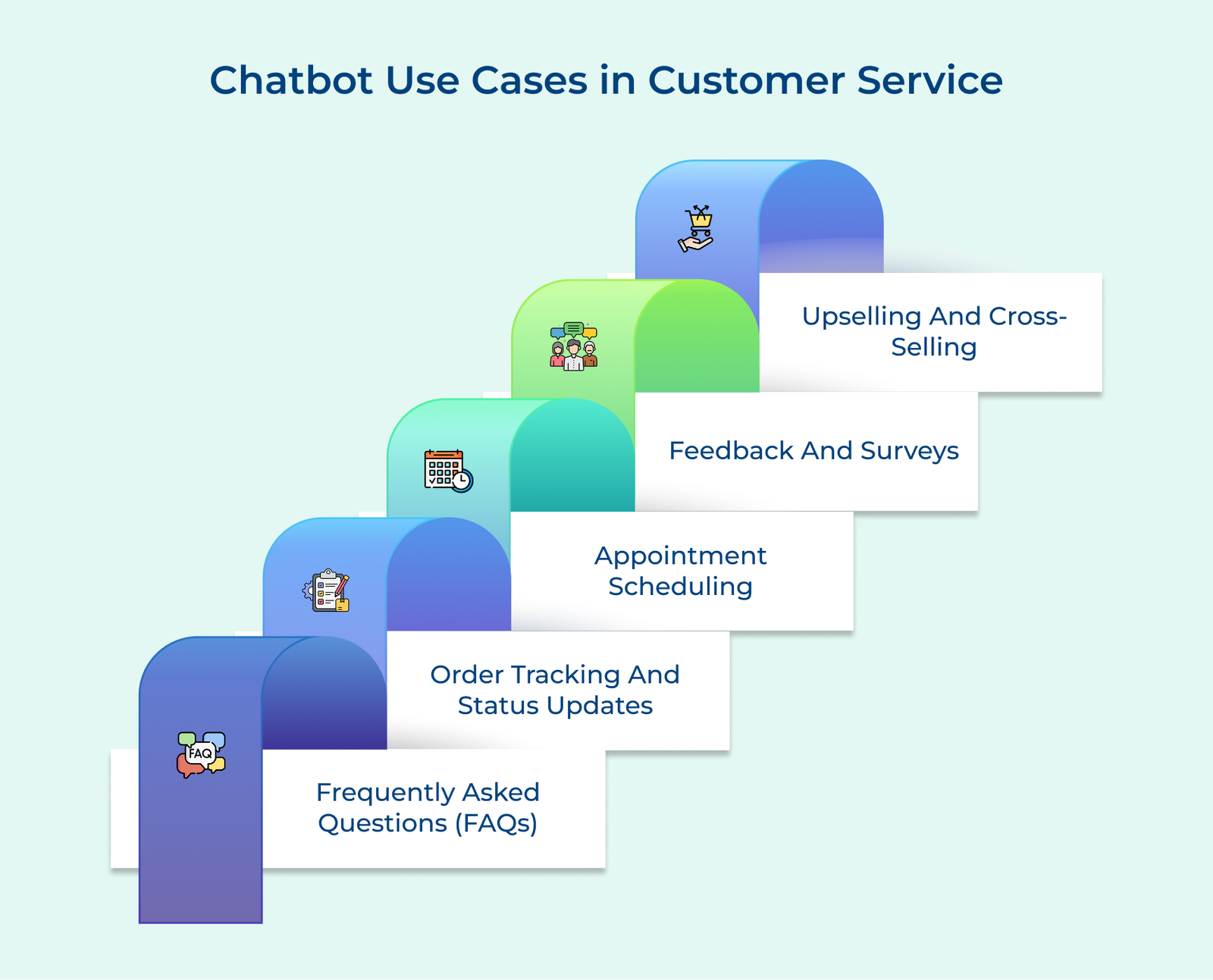
Gartner surveys suggest that by 2027, chatbots will become the primary channel for customer service in a quarter of all businesses. One of the most common uses of chatbots in customer service is to handle frequently asked questions. Businesses can provide instant and accurate answers to customers without requiring human intervention. Programmed with common responses, chatbots save resources for both customers and businesses.
62% of respondents are found to prefer interacting with a customer service chatbot than waiting for an agent to respond. Chatbots provide tracking numbers, delivery estimates and updates on demand. It makes order information more accessible and timely.
Businesses like clinics and salons use chatbots to manage appointments. Customers can check availability, book slots and receive confirmations automatically. It reduces scheduling errors and eliminates the need for manual handling.
Chatbots can collect customer feedback immediately after an interaction. They prompt users to share their experiences, rate satisfaction and offer suggestions. It helps businesses gather insights quickly and accurately.
57% of businesses believe that chatbot usage results in a huge ROI with minimal investments. Chatbots can suggest complementary products or upgrades based on customers’ previous purchases, leading to increased sales. Chatbots can identify opportunities for upselling or cross-selling, providing customers with personalized offers and recommendations. It is simply done by analyzing customer data & behavior.
Let’s go through the dynamic world of conversational AI and explore various use cases that are revolutionizing customer service
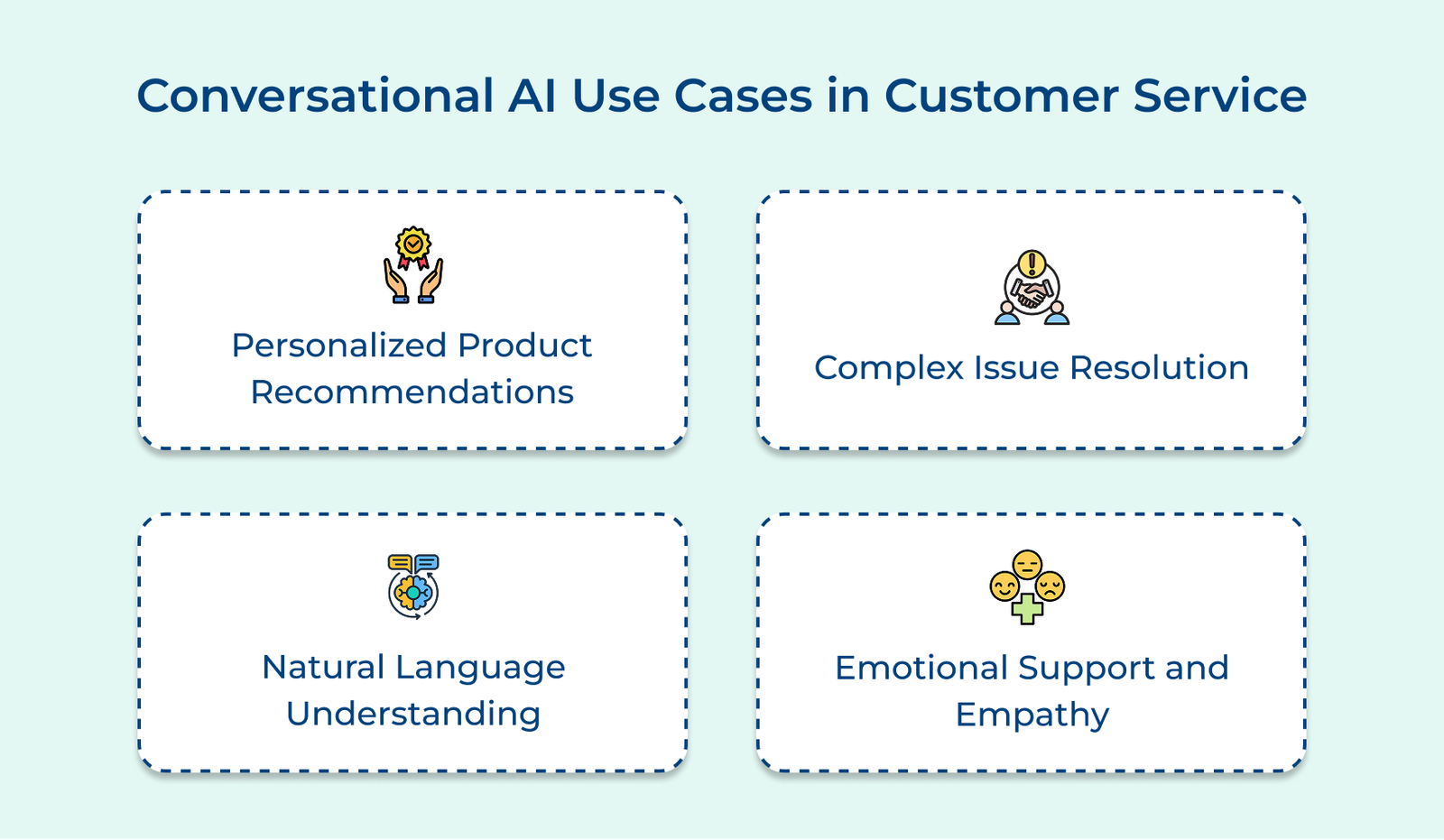
As MIT Technology Review states, 80% of executives reported improved customer satisfaction, service delivery and contact center performance with conversational AI. Businesses can provide product recommendations based on customer preferences and purchase history. Chatbots can identify customer needs and suggest relevant products by analyzing data.
Conversational AI is particularly useful in handling complex customer issues that may require technical expertise or intricate troubleshooting. Chatbots can collect information, diagnose issues and offer solutions or route customers to the right support team. It not only saves time and resources but also ensures accurate resolutions.
A significant advantage of conversational AI is its ability to understand natural language. Unlike traditional systems, chatbots interpret questions more accurately for better interactions. Using natural language processing, chatbots understand language nuances and give relevant responses.
Chatbots can recognize and respond to customer emotions beyond problem solving. They help customers feel understood and supported throughout the interaction by simulating empathetic, human-like responses.
Let’s go through the relationship between chatbots and conversational AI, understanding how they work together to streamline processes:
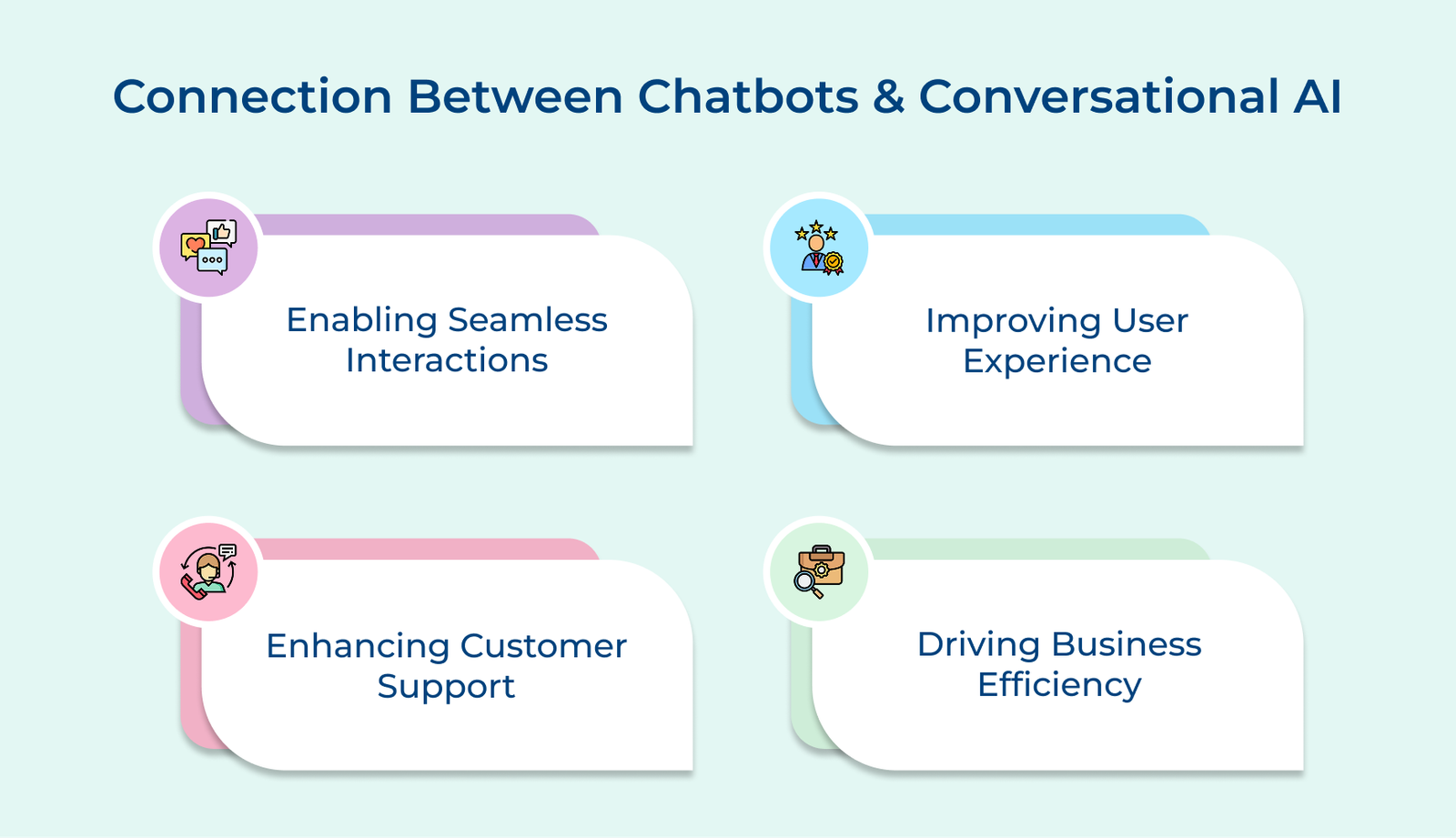
1. Enabling seamless interactions: Chatbots serve as the interface for conversational AI, letting users communicate naturally with AI systems. They combine technologies like voice recognition, sentiment analysis, contextual understanding and personalized responses to make interactions smooth.
2. Improving user experience: Chatbots powered by conversational AI can enhance user experiences by providing instant responses to queries. They can handle repetitive, routine tasks efficiently and without human intervention, allowing businesses to save time.
3. Enhancing customer support: Chatbots can manage a wide range of queries around the clock, reducing wait times and improving responsiveness. They can detect customer sentiment and adjust responses to create more empathetic, human-like interactions.
4. Driving business efficiency: Chatbots can automate processes, like appointment scheduling, order tracking and information retrieval. They provide consistent answers, handle multiple users at once and reduce errors. Businesses can allocate human resources to other strategic initiatives, improving overall operational efficiency.
Below are the advantages conversational AI offers over traditional chatbots by providing more intelligent and human-like interactions that enhance customer experience.
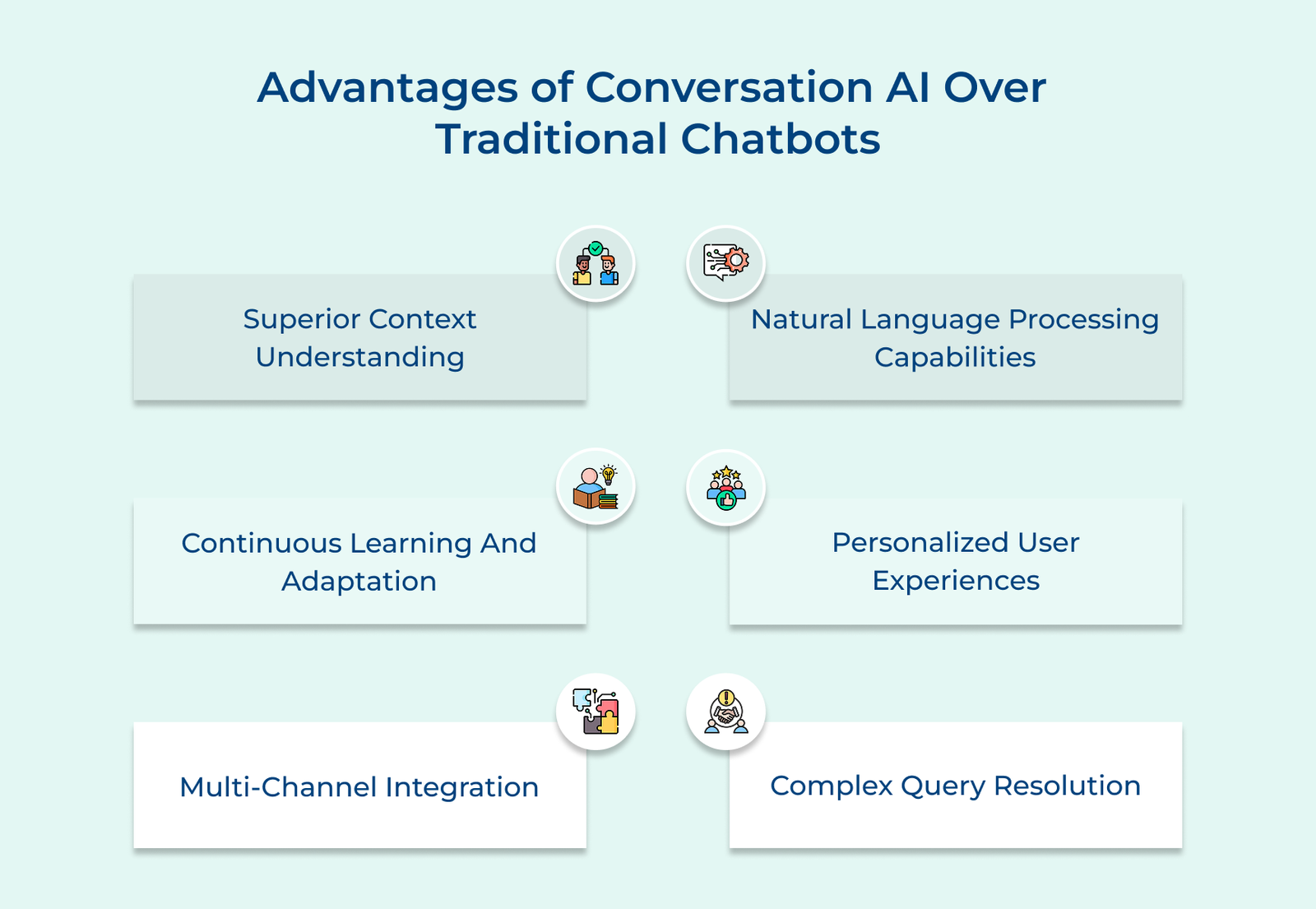
1. Superior context understanding
Conversational AI maintains conversation history and understands contextual references throughout interactions. Unlike traditional chatbots, it can follow complex multi-turn conversations without losing track of previous exchanges.
2. Natural language processing capabilities
Advanced NLP allows conversational AI to interpret varied speech patterns and colloquialisms naturally. It understands language nuances that traditional rule-based chatbots often fail to handle.
3. Continuous learning and adaptation
Conversational AI improves through use, learning from each interaction to refine future responses. Traditional chatbots stay static and require manual updates.
4. Personalized user experiences
Conversational AI analyzes user data to deliver personalized responses and recommendations for individual preferences. Traditional chatbots rely on fixed scripts, making interactions less personal.
5. Multi-channel integration
Conversational AI works smoothly across voice, chat and other platforms without separate programming. Traditional chatbots usually struggle to adapt outside their original channel.
6. Complex query resolution
Conversational AI can manage layered, multi-step problems that require reasoning. Traditional chatbots break down when faced with issues beyond their pre-programmed scenarios.
Both chatbots and conversational AI can improve customer service, but they work in different ways. Chatbots are useful for quick, routine questions, while conversational AI can hold more natural, personalized conversations.
The right choice depends on your business goals. Integrating the tools into your customer service strategy can improve efficiency. It also reduces pressure on human agents, increases customer engagement and creates a smoother overall experience.
Chatbots along with the conversational AI are used across industries for tasks like customer support, lead generation, sales help, appointment scheduling or and acting as virtual assistants. They make interactions quicker, easier and more accessible for both businesses as well as customers.
Chatbots learn through predefined rules and patterns, while conversational AI utilizes machine learning algorithms. Conversational AI systems can learn from vast amounts of data and adapt to user interactions over time. It allows them to continuously improve their responses, understand user preferences and provide more personalized interactions.
They can’t fully replace human agents. Chatbots and conversational AI are best for routine or repetitive tasks, providing quick answers or handling multiple inquiries at once. Human agents are still needed for complex cases and interactions that require empathy or nuanced problem-solving.
Security is a crucial consideration when implementing chatbots and conversational AI. It is essential to ensure that the systems are built with robust security measures to protect sensitive information. Encryption, authentication and access control mechanisms should be implemented to safeguard the data.
Companies can build their own systems or use existing platforms and frameworks. The key steps are setting clear goals, understanding user needs and refining the system over time using feedback.
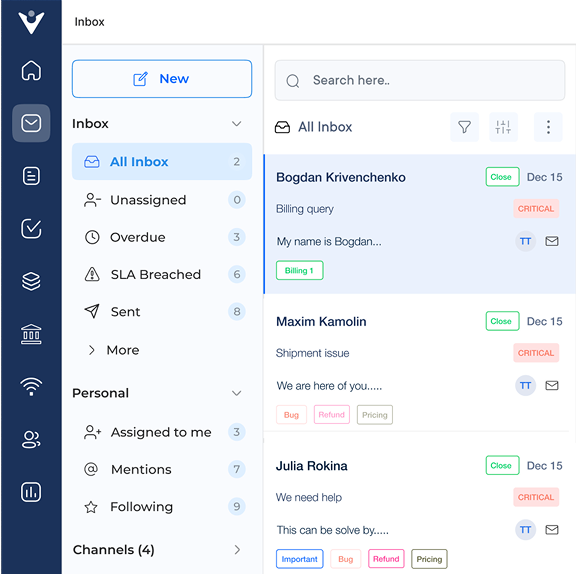
Market better, sell faster and support smarter with Veemo’s Conversation Customer Engagement suite of products.
Unify all your customer data in one platform to deliver contextual responses. Get a 360 degree view of the customer lifecycle without switching tools.
Connect with the tools you love to reduce manual activities and sync your business workflows for a seamless experience.
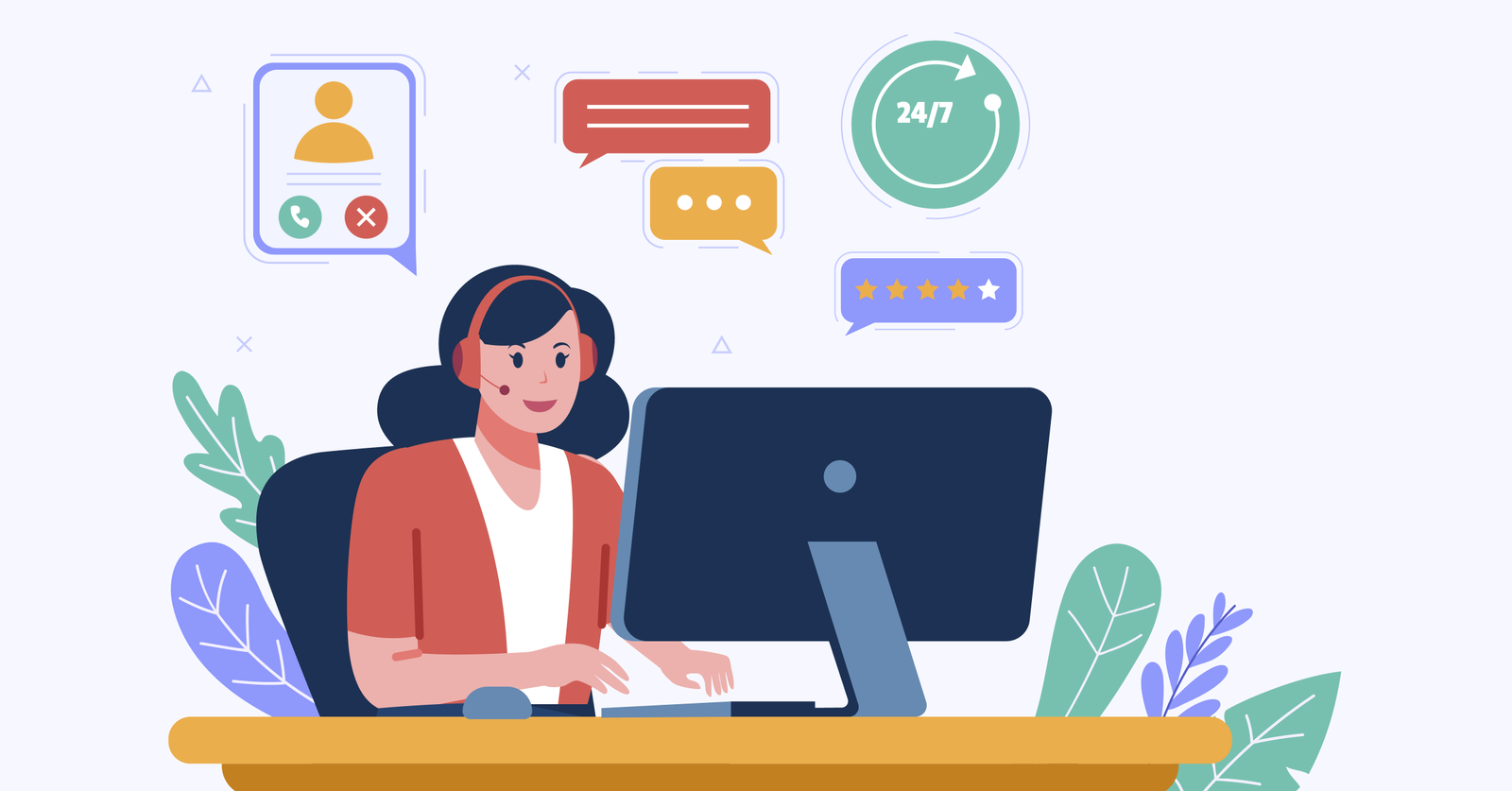 https://veemo.io/wp-content/uploads/2024/12/customer-service-response-time.png
1256
2400
Webvision Solution
https://veemo.io/wp-content/uploads/2024/11/veemo.svg
Webvision Solution2025-10-17 10:51:142025-10-17 10:51:149 Effective Tips to Reduce Customer Service Response Time
https://veemo.io/wp-content/uploads/2024/12/customer-service-response-time.png
1256
2400
Webvision Solution
https://veemo.io/wp-content/uploads/2024/11/veemo.svg
Webvision Solution2025-10-17 10:51:142025-10-17 10:51:149 Effective Tips to Reduce Customer Service Response Time https://veemo.io/wp-content/uploads/2024/06/Customer-Communication-Best-Practices1.png
628
1200
Vikas Sachan
https://veemo.io/wp-content/uploads/2024/11/veemo.svg
Vikas Sachan2024-11-05 06:43:042024-11-05 06:43:04Top 15 Customer Communication Best Practices for Businesses
https://veemo.io/wp-content/uploads/2024/06/Customer-Communication-Best-Practices1.png
628
1200
Vikas Sachan
https://veemo.io/wp-content/uploads/2024/11/veemo.svg
Vikas Sachan2024-11-05 06:43:042024-11-05 06:43:04Top 15 Customer Communication Best Practices for Businesses https://veemo.io/wp-content/uploads/2024/02/Live-Chat-for-Sales.png
628
1200
teamwebvisionsolution@gmail.com
https://veemo.io/wp-content/uploads/2024/11/veemo.svg
teamwebvisionsolution@gmail.com2024-10-21 11:31:222025-08-06 10:22:06How to Use Live Chat for Sales? 7 Proven Ways to Grow Revenue
https://veemo.io/wp-content/uploads/2024/02/Live-Chat-for-Sales.png
628
1200
teamwebvisionsolution@gmail.com
https://veemo.io/wp-content/uploads/2024/11/veemo.svg
teamwebvisionsolution@gmail.com2024-10-21 11:31:222025-08-06 10:22:06How to Use Live Chat for Sales? 7 Proven Ways to Grow RevenueGrow Customer Relationships and stronger team collaboration with our range of products across the Conversational Engagement Suite.

 15 Top Help Desk KPIs & Metrics to Measure IT Support Performance
Scroll to top
15 Top Help Desk KPIs & Metrics to Measure IT Support Performance
Scroll to top